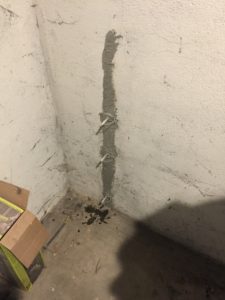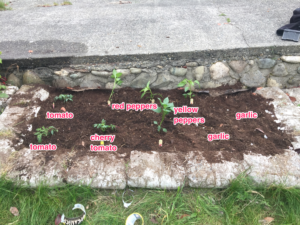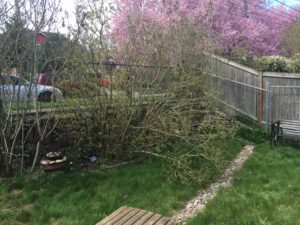I wasn’t feeling well last Sunday (for good reason, I got sick) and I slept in, but I felt like I should get something done, so I pulled out the tools and installed two of these USB combo sockets, one by the front door and one in my daughter’s room. Now I can put her watchphone charger by the door where she won’t forget it, and she can charge her tablet in her room without needing extension cords all over the place.
Good Deed For The Day
Oct 19
Updates and Plans
Jul 9
Good heavens, I haven’t posted here in months!
I have several things going at once:
- More and better gardening
- Master bedroom conversion
- Kitchen bumpout
Gardening
I picked up a couple of books on vegetable gardening, one of which — Vegetable Gardening in the Pacific Northwest: A Timber Press Guide — was particularly good and useful. This year I’ve planted three tomato plants (regular/hybrid, roma, and cherry), which typically have been growing like crazy; possibly helped by the fact that I’m actually fertilizing them once a week. Around and under them I planted a line of beans (plus a trellis for them to climb) and two rows of radishes. The radishes seem to be taking longer to grow than I thought they would.
Last year’s all-marigolds bed is now one third dwarf marigolds (planted more densely, and ruthlessly deadheaded so they bloom more), about one-fifth tall marigolds planted from seed, which are about three inches tall and probably won’t bloom until late August, and the rest in sweet corn and beans, both of which are growing great so far. There’s also a cucumber plant and a zucchini plant that I put in three weeks ago, but which don’t seem to have grown at all. Maybe it’s not hot enough yet.
I pulled out all the weeds and maybe-strawberries from the back bed, and planted six for-sure strawberry plants and a raspberry bush. The book says that you need to clip the runners from the strawberries to make them put their energy into fruiting, but I actually want them to take over the whole bed, so I’m letting them run all over and I can wait for lots of fruit until next year. I believe the same is going to be true of the raspberry.
Last, I planted a container box with bunching onions and carrots, and put it up high so hopefully the low-flying carrot rust bugs won’t get to it. I’m really planning on eating the onions in their scallion form, but I’ll leave a few until late to see if they work out as actual onion bulbs.
Something I learned from the aforementioned book is that gardening isn’t just a summer sport around here. There’s lots of things you can grow literally over the winter even if you hate kale. I’m planning on planting garlic in September and harvesting it in spring sometime.
Master Bedroom
The 20’x20′ flat-roofed addition on the original gable cottage was originally (in the 1960s) a single open family room. At some point, probably in the 1980s, a previous owner partitioned off about 10’x16′ of it to make a separate bedroom. When I got divorced and got a roommate for a couple of years, I walled off 14′ of the remaining open space to make a bedroom for his kids.
My ultimate intention for the addition is to turn it into a master suite, with bathroom and closet, but until I can do that I’m working on converting the two bedrooms into one 20’x14′ master bedroom. I’ve taken out the intermediate wall, drywalled over the kids’ room door, and resolved all the rat’s nest of electrical wiring (that I’m surprised hasn’t burned the house down yet). Now I’m in the process of patching the drywall and doing the mudding & taping that I never did before; then will come priming and painting and putting down new flooring, and then I’ll be able to move into it. So probably by Christmas, then.
Kitchen Bumpout
The big plan is to extend the back gable wall of the house out by 8′. Then I can build a new kitchen in that space, and then, when that’s completed, demolish the existing kitchen and turn it into a better dining room. Extending the existing space will let me have a straight staircase to the basement, better placement of the back door, even more windows than I have now, and most importantly enough room for a rationally-laid-out kitchen (no more ring-around-the-rosie around the cooktop/prep island if there’s more than one person in the kitchen).
To this end I refinanced the house (also got rid of my PMI) and took out a big whack of cash that is now sitting in a savings account ready to start being spent. All the contractors around here are reported to be super super busy with townhomes and McMansions, so I doubt that I’ll be able to find a design-build firm that will have time to help me. Which is okay, since I can do almost all of the work myself, it’ll just take longer.
What’s taking a long time right now is drafting blueprints. Once I have plans I can hire a structural engineer to review them and either suggest changes or sign off, and then I need to find a foundation contractor (I don’t think I can manage concrete). Once the foundation is done, I know I can do the framing, electrical, etc., and I’ll call the company that did the existing roof to apply the same special system to the new part.
It’s not clear if a bumpout of the basement plus ground floor is within the scope of a subject-to-field-inspection, but it it’s not then I understand it can take several months for approval, so I might not be able to start before next spring.
Basement Cracks Redux
Oct 21
Since clearly no more tomatoes are going to ripen since it’s dropped down into the 50s around here, I pulled out all the plants in the vegetable garden, weeded it, and covered it with black plastic to hopefully keep the morning glory and grass down until next Spring.
I’m leaving the marigolds bed because they’re still blooming, and I expect they’ll continue to do so until the first frosts in about a month.
Lessons learned:
- Allocate this bed just for tomatoes, spaced out more than this year.
- Grow one heirloom, one cherry, and one Roma tomato plant each, in order to avoid Tomatopocalypse 2018.
- Garlic and peppers should be grown in pots and started indoors way earlier in the year.
- Whatever those plants were that Home Depot labeled as “strawberries”, they definitely weren’t strawberries. Get starts from an actual nursery next year.
Basement Cracks
Oct 11
Gardening
Apr 29
It’s been a few years since I’ve had any vegetables in my raised beds, so today I went out and spent a bunch of money. Here’s the layout:
I’m sticking with tomatoes, peppers, and garlic in the main bed. I want stuff that will grow without too much intervention, like thinning or pruning, and that I know I will eat.
Then I built a mini-greenhouse out of garden stakes, zip ties, 3-mil sheeting, and 1x2s:
Since I’m cooking so much more than I used to, I want herbs that won’t go bad in the refrigerator between uses, so I’m going to try a windowsill herb garden. Left to right I have oregano, rosemary, thyme, and basil:
Last, I cleared out part of the bed over by the work shed and planted strawberries. I may clear out the rest of the bed and plant either raspberries or more strawberries.

And now to go inside and sit in my comfy chair before I get too much fresh air poisoning.
Seriously?!
Apr 15
At some point, you just have to wonder if the previous owners crossed the line from “blithering idiot” to “criminally insane”.
Since my roommate moved out, I’m going to break down the wall between his room (my old room) and his boys’ room (the former library, TV room, etc.) and make one big 20’x15′ bedroom. You can see the first step here:

However, just like when I tried to remove part of a heating duct last month, I find that I’m going to have to break the existing structure back further and further until I almost might as well just gut the whole thing right now.
For instance, inside the wall hidden by the door in the foreground, is this nonsense:


Hidden junction box, weird connector, individual conductors stripped out of the sheath and passed through holes, and (not pictured) wires in a notch between a 2×4 and the drywall with no protector plate.
I’m ever more convinced that the previous owners (ptui) wired up the addition with a bunch of 6′-8′ lengths of wire they got surplus and just connected together any old how. At least they’re not just wire-nutted together end-to-end hidden inside the wall, like I found before when I was wiring up the hall lights.
And it looks like they built the wall between the rooms and then put in the ceilings. There’s all this structure between the beams and attached to the roof deck up inside the ceiling, that to remove and insulate the cavity, I’m probably going to have to remove a couple of feet of drywall on either side of the joint. And pretty much rebuild the wall that’s got all the weird electrical in it as well.
Idiots!
Lilac Down!
Apr 4
Jen stopped by the other day and pointed out that one of the lilacs against the retaining wall at the front of the property had fallen over.
Turns out all the main trunks of the middle lilac were completely rotten and mostly hollow.
I’m starting to wonder if maybe lilacs just aren’t supposed to get to tree size, since the lilac in the side yard that was twenty feet tall with a 10″ trunk was also rotten and hollow before I cut it down. In any case, I pulled out the rest of that lilac, and what’s left is a whole bunch of 1/4″ shoots coming up from the ground next to the stump, so I guess those are fine.
Honestly, I’m starting to wonder if maybe I just shouldn’t pull them all out and replace them with something that’s going to do a better job of screening and will look nicer. They’re not particularly pretty even when they’re in bloom, and they’re kind of thin and unruly, and evidently if they continue on they’ll rot and fall over anyway. I suppose I could fertilize them and see if they perked up and came in better, but I suspect I’d just end up fertilizing the morning glory and blackberries that keep trying to take over that bed.
I always thought of this house as having no particular architectural style at all, having been knocked together by a penurious homeowner in the early Depression out of whatever materials came to hand.
Apparently that applies to about a million other houses built around the same time, and behold! it has a named style after all:
Minimal Traditional is a style of architecture that emerged in mid 20th century America as a vernacular form that incorporates influences from earlier styles such as American Colonial, Colonial Revival, Spanish Revival, Tudor Revival, and American Craftsman while adhering to modern architecture‘s avoidance of ornament.
The Minimal Traditional style evolved during the 1930s and was a dominant style in domestic architecture until the Ranch-style house emerged in the early 1950s. Descending in part from the bungalows, cottages, and foursquare houses of the early 20th century, Minimal Traditional houses represent a “stripped-down version of the historic-eclectic styles popular in the 1920s”. They are usually detached single-family houses that are on the smaller side and retain simplified versions of the built-in cabinets that were popular features of the Craftsman era. Typical features include hipped or gabled roofs without much in the way of eaves; cladding in locally popular materials such as wood, brick or stone; small porches; and an asymmetrical design with the front door set off center.
The Minimal Traditional house “fulfilled aesthetic and social needs for affordable single-family housing” and was used by the Federal Housing Administration as a prototype for a “minimum house that the majority of American wage earners could afford”.
Minimal Traditional houses have been tagged with some other names: FHA house, Depression-era cottage, Victory cottage, and American small house.
— https://en.wikipedia.org/wiki/Minimal_Traditional
Other links:
Minimal Traditional Style — 1925 to 1950
Minimal Traditional Architecture
Of course, people have been poking it with a stick since at least the 1960s, and now it’s kind of a mishmash. I have some plans for bringing it back into stylistic harmony (mainly replacing the flat roof with a gable matching the existing one, and a porch across the front), but I could extend the overhangs and nail brackets on it all day long and it’d never be a bungalow.








